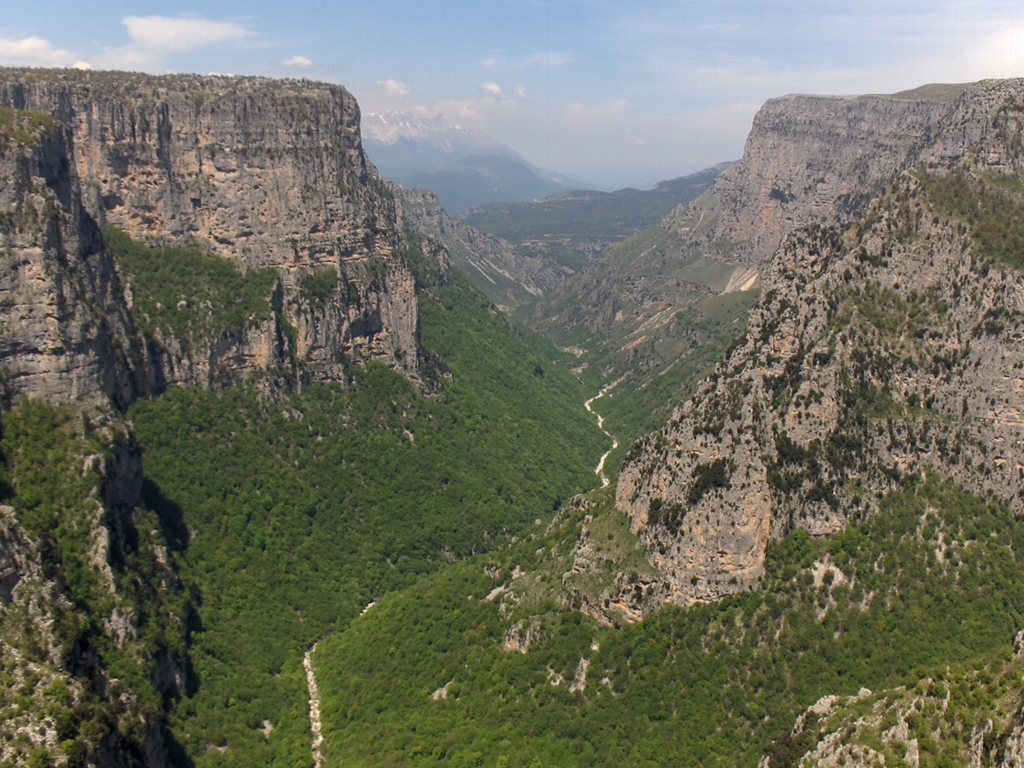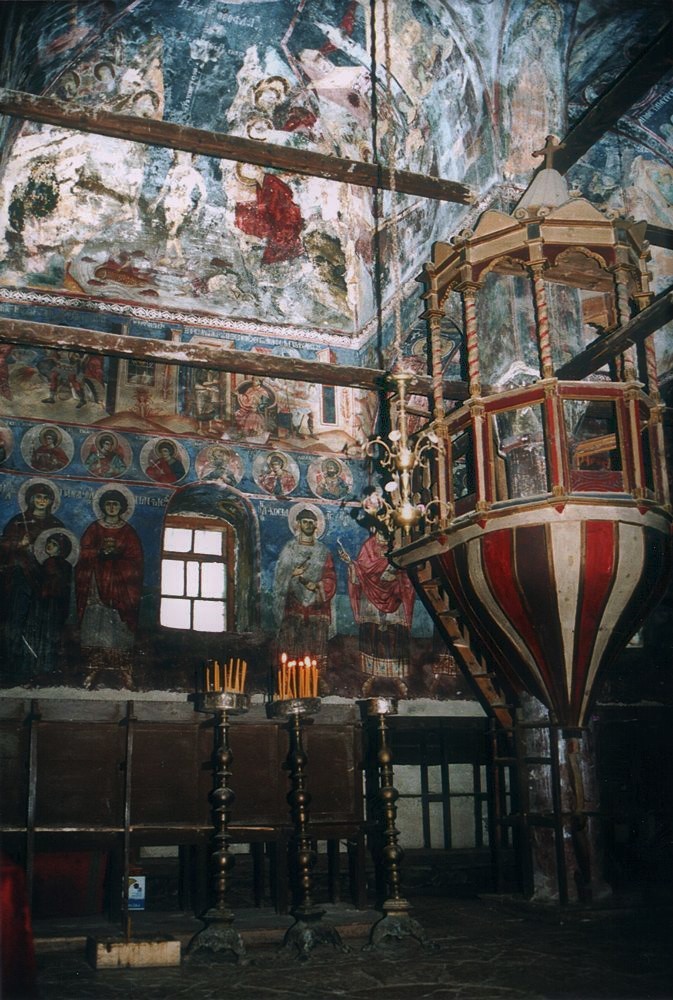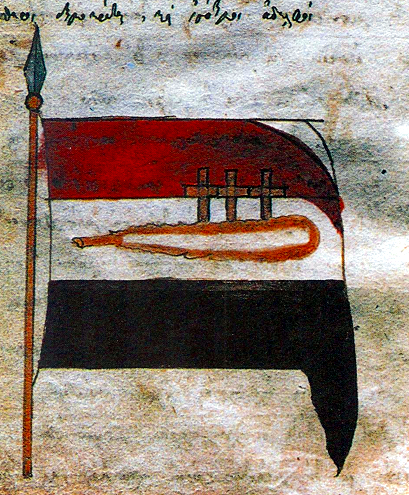|
Kapesovo
Kapesovo ( el, Καπέσοβο) is a village in the Zagori region (Epirus region), it is 43 km north of Ioannina. The name Kapesovo is Slavic and means garden. The village used to be more south near Baya (Kipi), where many vegetables were grown and it was called "Kapouska". It was later moved to its current position for health reasons. There is a big cliff next to the village called "Kapesios" (a Slavic word that means cliff) and the name of the village might be related to it. The village is near the Vikos canyon, the view of which is spectacular at certain spots. History In the 18th and 19th centuries Kapesovo was renowned in Epirus for its painters, called mpogades ( el, Μπογάδες), that worked in dozens of churches from Moscopole to Arta. Kapesovo experienced a great flourishing until 1860 and this is evident in the great manors with folk wall paintings and churches with paintings (hagiographies) in their interior. The church of Aghios Nikolaos, built in 1793, ... [...More Info...] [...Related Items...] OR: [Wikipedia] [Google] [Baidu] |
Zagori
Zagori ( el, Ζαγόρι; rup, Zagori), is a region and a municipality in the Pindus mountains in Epirus, in northwestern Greece. The seat of the municipality is the village Asprangeloi. It has an area of some and contains 46 villages known as Zagori villages (or Zagorochoria or Zagorohoria), and is in the shape of an upturned equilateral triangle. Ioannina, the provincial capital, is at the southern point of the triangle, while the south-western side is formed by Mount Mitsikeli (1,810m). The Aoos river running north of Mt Tymphe forms the northern boundary, while the south-eastern side runs along the Varda river to Mount Mavrovouni (2,100m) near Metsovo. The municipality has an area of 989.796 km2. The population of the area is about 3,700, which gives a population density of 4 inhabitants per square kilometer, very sparse when compared to an average of 73.8 for Greece as a whole. Geography Zagori is an area of great natural beauty, with striking geology and two Natio ... [...More Info...] [...Related Items...] OR: [Wikipedia] [Google] [Baidu] |
Vradeto
Vradeto ( el, Βραδέτο) is a village in the Greek Zagori region ( Epirus region). It lies at a height of 1340m on Mt Tymphe in the Pindus mountain range. It is the highest of the 44 villages of Zagori. It is the middle of the Vikos–Aoös National Park and is about 50 km away from Ioannina. It is located only a few kilometers from the Vikos Gorge and near one of the best vantage points, Beloe (Beloi) (perhaps a Slavic word meaning "good view" or "balcony"). It is located also close to an alpine lake called Drakolimni (''Dragon’s Lake''), one of several such lakes. The lakes are named after the amphibian newts ('' Ichthyosaura alpestris'') that live in them, around which there are myths of dragons. The myths are echoes of ancient myths about the hero Pindus, son of Macedon, who either befriended or according to another myth killed a dragon. Nearest places *Tsepelovo, east (distance: 10 km) * Kapesovo, south (distance: 5 km) Population History Until t ... [...More Info...] [...Related Items...] OR: [Wikipedia] [Google] [Baidu] |
Tymfi, Greece
Tymfi ( el, Τύμφη) is a former municipality in the Ioannina regional unit, Epirus, Greece. Since the 2011 local government reform it is part of the municipality Zagori, of which it is a municipal unit. The municipal unit has an area of 428.296 km2. Population 862 (2011). The seat of the municipality was in Tsepelovo. It took its name from the Tymfi mountain. Subdivisions The municipal unit Tymfi is subdivided into the following communities: *Tsepelovo *Vradeto * Vrysochori * Iliochori *Kapesovo * Kipoi * Koukouli * Laista *Leptokarya * Negades *Skamneli Skamneli ( el, Σκαμνέλι) is a village in the Zagori region ( Epirus region), 54 km north of Ioannina. It is built in the fringes of mountain Tymfi (Mt Tymphe), at a height of 1160 m. Name The name "Skamneli" is of uncertain origi ... * Fragkades References Zagori Populated places in Ioannina (regional unit) {{Epirus-geo-stub de:Tymfi ... [...More Info...] [...Related Items...] OR: [Wikipedia] [Google] [Baidu] |
Epirus (region)
Epirus (; el, Ήπειρος, translit=Ípiros, ) is a traditional geographic and modern administrative region in northwestern Greece.Π.Δ. 51/87 “Καθορισμός των Περιφερειών της Χώρας για το σχεδιασμό κ.λ.π. της Περιφερειακής Ανάπτυξης” (''Determination of the Regions of the Country for the planning etc. of the development of the regions, Efimeris tis Kyverniseos ΦΕΚ A 26/06.03.1987'' It borders the regions of Western Macedonia and Thessaly to the east, West Greece to the south, the Ionian Sea and Ionian Islands to the west and Albania to the north. The region has an area of about . It is part of the wider historical region of Epirus, which overlaps modern Albania and Greece but lies mostly within Greek territory. Geography and ecology Greek Epirus, like the region as a whole, is rugged and mountainous. It comprises the land of the ancient Molossians and Thesprotians and a small part of the la ... [...More Info...] [...Related Items...] OR: [Wikipedia] [Google] [Baidu] |
Ioannina (regional Unit)
Ioannina ( el, Περιφερειακή ενότητα Ιωαννίνων) is one of the regional units of Greece. It is part of the region of Epirus. Its capital is the city of Ioannina. It is the largest regional unit in Epirus, and one of the largest regional units of Greece, with a population of 167,901 people, according to the 2011 census.GOV. results of permanent population 2011, p. 10561 (p. 87 of pdf), and in Excel formatTable of permanent population 2011 from the sitHellenic Statistical Authority 2017-11-24. Retrieved 2018-01-09. Geography Ioannina borders in the north, and the regional units of |
Ioannina
Ioannina ( el, Ιωάννινα ' ), often called Yannena ( ' ) within Greece, is the capital and largest city of the Ioannina regional unit and of Epirus, an administrative region in north-western Greece. According to the 2011 census, the city population was 65,574, while the municipality had 112,486 inhabitants.GOV. results of permanent population 2011, p. 10571 (p. 97 of pdf), and in Excel formatTable of permanent population 2011 from the sitHellenic Statistical Authority 24 November 2017. Retrieved 2018-01-09. It lies at an elevation of approximately above sea level, on the western shore of |
Slavic Languages
The Slavic languages, also known as the Slavonic languages, are Indo-European languages spoken primarily by the Slavic peoples and their descendants. They are thought to descend from a proto-language called Proto-Slavic, spoken during the Early Middle Ages, which in turn is thought to have descended from the earlier Proto-Balto-Slavic language, linking the Slavic languages to the Baltic languages in a Balto-Slavic group within the Indo-European family. The Slavic languages are conventionally (that is, also on the basis of extralinguistic features) divided into three subgroups: East, South, and West, which together constitute more than 20 languages. Of these, 10 have at least one million speakers and official status as the national languages of the countries in which they are predominantly spoken: Russian, Belarusian and Ukrainian (of the East group), Polish, Czech and Slovak (of the West group) and Bulgarian and Macedonian (eastern dialects of the South group), and Serbo-C ... [...More Info...] [...Related Items...] OR: [Wikipedia] [Google] [Baidu] |
Vikos Canyon
The Vikos Gorge or Vikos Canyon ( gr, Φαράγγι του Βίκου) is a gorge in the Pindus Mountains of north-western Greece. It lies on the southern slopes of Mount Tymphe with a length of about 32 km, depth ranging from 120 to 1350 m, and a width ranging from 2500 m to only a few meters at its narrowest part. Vikos is listed as the world's "deepest relative to its width" gorge by the Guinness Book of Records among others. Etymology There are a number of views regarding the etymology of the name: *According to Ioannis Lambridis it derives from Slavic and means 'chasm' or 'gorge'. *According to Evangelos Bogas it derives from the Greek βίκος 'stamnos with ears', which denotes the shape of the gorge and the echoes caused by sounds within it. The word was recorded in the lexicon of Hesychius of Alexandria. *According to Konstantinos Amantos it derives from the Greek phytonym βικίον. *According to Konstantinos Oikonomou it derives from an Albanian word for ... [...More Info...] [...Related Items...] OR: [Wikipedia] [Google] [Baidu] |
Moscopole
Moscopole or Voskopoja ( sq, Voskopojë; rup, Moscopole, with several other variants; el, Μοσχόπολις, Moschopolis) is a village in Korçë County in southeastern Albania. During the 18th century, it was the cultural and commercial center of the Aromanians. At its peak, in the mid 18th century, it hosted the first printing house in the Ottoman Balkans outside Constantinople, educational institutions and numerous churches. It became a leading center of Greek culture, but also of symbiotic Albanian–Aromanian culture and with great influence from Western civilization. One view attributes the decline of the city to a series of raids by Muslim Albanian bandits. Moscopole was initially attacked and almost destroyed by those groups in 1769 following the participation of the residents in the preparations for a Greek revolt supported by the Russian Empire. Its destruction culminated with the abandoning and destruction of 1788. Moscopole, once a prosperous city, was reduce ... [...More Info...] [...Related Items...] OR: [Wikipedia] [Google] [Baidu] |
Arta, Greece
Arta ( el, Άρτα) is a city in northwestern Greece, capital of the regional unit of Arta, which is part of Epirus region. The city was known in ancient times as Ambracia ( grc, Ἀμβρακία). Arta is known for the medieval bridge over the Arachthos River. Arta is also known for its ancient sites from the era of Pyrrhus of Epirus and its well-preserved 13th-century castle. Arta's Byzantine history is reflected in its many Byzantine churches; perhaps the best known is the Panagia Paregoretissa (Mother of God the Consoling), built about 1290 by Despot Nikephoros I Komnenos Doukas. Etymology The origin of the city's name is quite uncertain. It's either derived from a corruption of the river Arachthos, either from the Latin word "artus" (narrow) either from the Slavic word "balta" (swamp). History Antiquity The first settlement in the area of the modern city dates to the 9th century B.C. Ambracia was founded as a Corinthian colony in the 7th century B.C. In 294 BC, af ... [...More Info...] [...Related Items...] OR: [Wikipedia] [Google] [Baidu] |
Rigas Fereos
Rigas Feraios ( el, Ρήγας Φεραίος , sometimes ''Rhegas Pheraeos''; rup, Riga Fereu) or Velestinlis (Βελεστινλής , also transliterated ''Velestinles''); 1757 – 24 June 1798), born as Antonios Rigas Velestinlis ( el, Αντώνιος Ρήγας Βελεστινλής), was a Greek writer, political thinker and revolutionary, active in the Modern Greek Enlightenment. A victim of the Balkan uprising against the Ottoman Empire and a pioneer of the Greek War of Independence, Rigas Feraios is today remembered as a national hero in Greece. Early life Rigas Feraios was born in 1757 as Antonios Rigas Velestinlis into a wealthy family in the village of Velestino in the Sanjak of Tirhala, Ottoman Empire (modern Thessaly, Greece). He later was at some point nicknamed ''Pheraeos'' or ''Feraios'', by scholars, after the nearby ancient Greek city of Pherae, but he does not seem ever to have used this name himself; he is also sometimes known as ''Konstantinos'' or ... [...More Info...] [...Related Items...] OR: [Wikipedia] [Google] [Baidu] |
Eastern Orthodox Church
The Eastern Orthodox Church, also called the Orthodox Church, is the second-largest Christian church, with approximately 220 million baptized members. It operates as a communion of autocephalous churches, each governed by its bishops via local synods. The church has no central doctrinal or governmental authority analogous to the head of the Roman Catholic Church—the Pope—but the Ecumenical Patriarch of Constantinople is recognized by them as '' primus inter pares'' ("first among equals"), which may be explained as a representative of the church. As one of the oldest surviving religious institutions in the world, the Eastern Orthodox Church has played a prominent role in the history and culture of Eastern and Southeastern Europe. The Eastern Orthodox Church officially calls itself the Orthodox Catholic Church. Eastern Orthodox theology is based on holy tradition, which incorporates the dogmatic decrees of the seven ecumenical councils, the Scriptures, and the teachin ... [...More Info...] [...Related Items...] OR: [Wikipedia] [Google] [Baidu] |






_3.jpg)

